Advanced Financial Accounting: Analyzing Enron's Financial Practices
VerifiedAdded on 2023/06/04
|8
|1993
|495
Report
AI Summary
This report provides a comprehensive analysis of Enron's financial accounting practices, addressing the misuse of mark-to-market accounting, the role of special purpose entities (SPEs), and the implications of stock options. It begins by defining mark-to-market accounting and illustrating how Enron's management allegedly manipulated this method to inflate profits, particularly through the Blockbuster and Indian electricity supply contracts. The report then delves into SPEs, explaining their function in debt settlement and the ways Enron used them to conceal liabilities and misrepresent financial performance. Finally, it examines Enron's stock option compensation scheme for top management, arguing that it conflicted with agency theory, as the management's interests were not aligned with those of the shareholders. The second part of the report assesses the measurement methods for the five elements of financial statements (assets, liabilities, revenue, expenses, and equity) using the CBA bank of Australia as an example, highlighting the use of fair value and historical cost methods. It also explains the bond liabilities and interest expense including the straight-line and effective interest methods. The report concludes by emphasizing the importance of choosing appropriate measurement methods for accurate and decision-useful financial information.
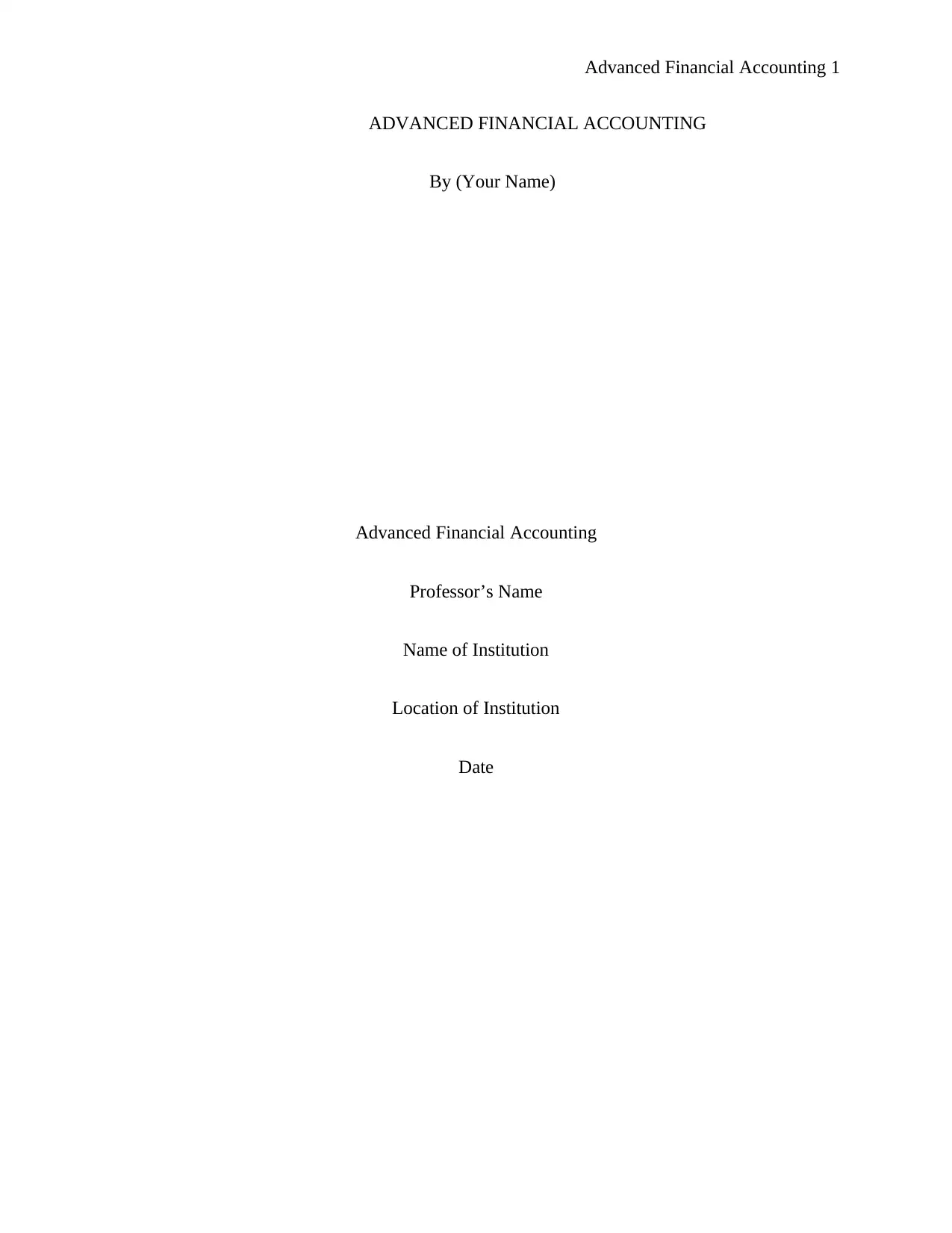
Advanced Financial Accounting 1
ADVANCED FINANCIAL ACCOUNTING
By (Your Name)
Advanced Financial Accounting
Professor’s Name
Name of Institution
Location of Institution
Date
ADVANCED FINANCIAL ACCOUNTING
By (Your Name)
Advanced Financial Accounting
Professor’s Name
Name of Institution
Location of Institution
Date
Paraphrase This Document
Need a fresh take? Get an instant paraphrase of this document with our AI Paraphraser
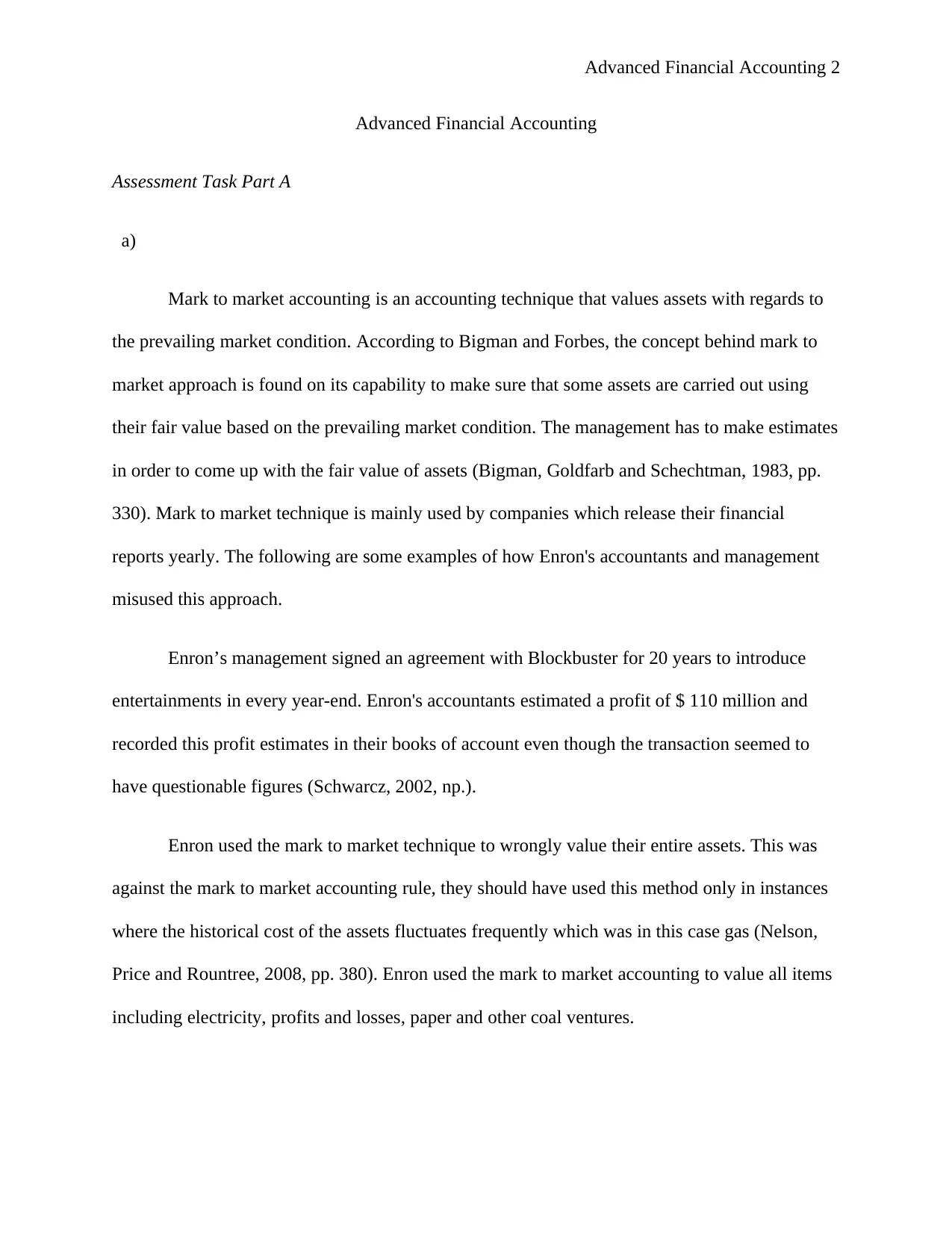
Advanced Financial Accounting 2
Advanced Financial Accounting
Assessment Task Part A
a)
Mark to market accounting is an accounting technique that values assets with regards to
the prevailing market condition. According to Bigman and Forbes, the concept behind mark to
market approach is found on its capability to make sure that some assets are carried out using
their fair value based on the prevailing market condition. The management has to make estimates
in order to come up with the fair value of assets (Bigman, Goldfarb and Schechtman, 1983, pp.
330). Mark to market technique is mainly used by companies which release their financial
reports yearly. The following are some examples of how Enron's accountants and management
misused this approach.
Enron’s management signed an agreement with Blockbuster for 20 years to introduce
entertainments in every year-end. Enron's accountants estimated a profit of $ 110 million and
recorded this profit estimates in their books of account even though the transaction seemed to
have questionable figures (Schwarcz, 2002, np.).
Enron used the mark to market technique to wrongly value their entire assets. This was
against the mark to market accounting rule, they should have used this method only in instances
where the historical cost of the assets fluctuates frequently which was in this case gas (Nelson,
Price and Rountree, 2008, pp. 380). Enron used the mark to market accounting to value all items
including electricity, profits and losses, paper and other coal ventures.
Advanced Financial Accounting
Assessment Task Part A
a)
Mark to market accounting is an accounting technique that values assets with regards to
the prevailing market condition. According to Bigman and Forbes, the concept behind mark to
market approach is found on its capability to make sure that some assets are carried out using
their fair value based on the prevailing market condition. The management has to make estimates
in order to come up with the fair value of assets (Bigman, Goldfarb and Schechtman, 1983, pp.
330). Mark to market technique is mainly used by companies which release their financial
reports yearly. The following are some examples of how Enron's accountants and management
misused this approach.
Enron’s management signed an agreement with Blockbuster for 20 years to introduce
entertainments in every year-end. Enron's accountants estimated a profit of $ 110 million and
recorded this profit estimates in their books of account even though the transaction seemed to
have questionable figures (Schwarcz, 2002, np.).
Enron used the mark to market technique to wrongly value their entire assets. This was
against the mark to market accounting rule, they should have used this method only in instances
where the historical cost of the assets fluctuates frequently which was in this case gas (Nelson,
Price and Rountree, 2008, pp. 380). Enron used the mark to market accounting to value all items
including electricity, profits and losses, paper and other coal ventures.
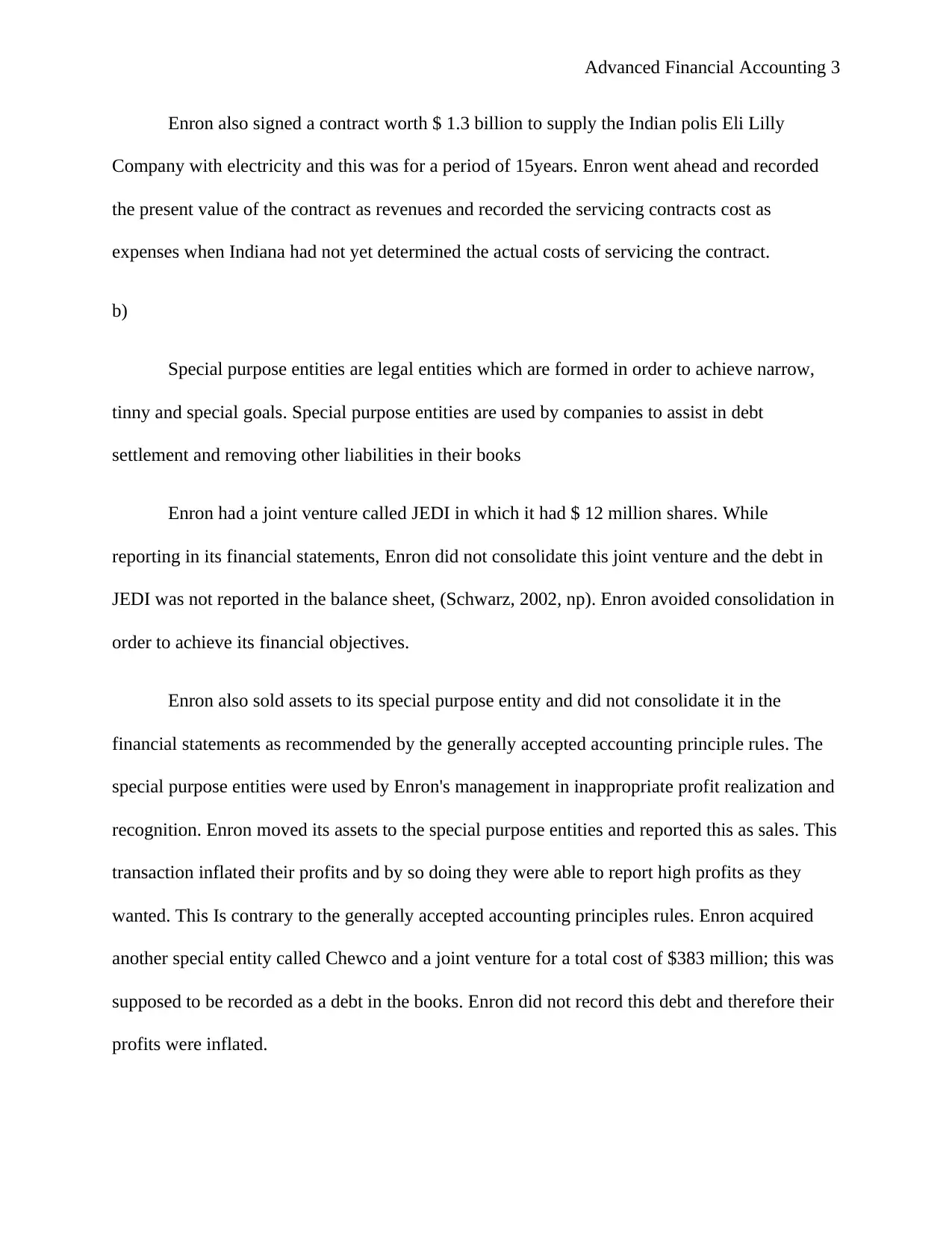
Advanced Financial Accounting 3
Enron also signed a contract worth $ 1.3 billion to supply the Indian polis Eli Lilly
Company with electricity and this was for a period of 15years. Enron went ahead and recorded
the present value of the contract as revenues and recorded the servicing contracts cost as
expenses when Indiana had not yet determined the actual costs of servicing the contract.
b)
Special purpose entities are legal entities which are formed in order to achieve narrow,
tinny and special goals. Special purpose entities are used by companies to assist in debt
settlement and removing other liabilities in their books
Enron had a joint venture called JEDI in which it had $ 12 million shares. While
reporting in its financial statements, Enron did not consolidate this joint venture and the debt in
JEDI was not reported in the balance sheet, (Schwarz, 2002, np). Enron avoided consolidation in
order to achieve its financial objectives.
Enron also sold assets to its special purpose entity and did not consolidate it in the
financial statements as recommended by the generally accepted accounting principle rules. The
special purpose entities were used by Enron's management in inappropriate profit realization and
recognition. Enron moved its assets to the special purpose entities and reported this as sales. This
transaction inflated their profits and by so doing they were able to report high profits as they
wanted. This Is contrary to the generally accepted accounting principles rules. Enron acquired
another special entity called Chewco and a joint venture for a total cost of $383 million; this was
supposed to be recorded as a debt in the books. Enron did not record this debt and therefore their
profits were inflated.
Enron also signed a contract worth $ 1.3 billion to supply the Indian polis Eli Lilly
Company with electricity and this was for a period of 15years. Enron went ahead and recorded
the present value of the contract as revenues and recorded the servicing contracts cost as
expenses when Indiana had not yet determined the actual costs of servicing the contract.
b)
Special purpose entities are legal entities which are formed in order to achieve narrow,
tinny and special goals. Special purpose entities are used by companies to assist in debt
settlement and removing other liabilities in their books
Enron had a joint venture called JEDI in which it had $ 12 million shares. While
reporting in its financial statements, Enron did not consolidate this joint venture and the debt in
JEDI was not reported in the balance sheet, (Schwarz, 2002, np). Enron avoided consolidation in
order to achieve its financial objectives.
Enron also sold assets to its special purpose entity and did not consolidate it in the
financial statements as recommended by the generally accepted accounting principle rules. The
special purpose entities were used by Enron's management in inappropriate profit realization and
recognition. Enron moved its assets to the special purpose entities and reported this as sales. This
transaction inflated their profits and by so doing they were able to report high profits as they
wanted. This Is contrary to the generally accepted accounting principles rules. Enron acquired
another special entity called Chewco and a joint venture for a total cost of $383 million; this was
supposed to be recorded as a debt in the books. Enron did not record this debt and therefore their
profits were inflated.
⊘ This is a preview!⊘
Do you want full access?
Subscribe today to unlock all pages.

Trusted by 1+ million students worldwide
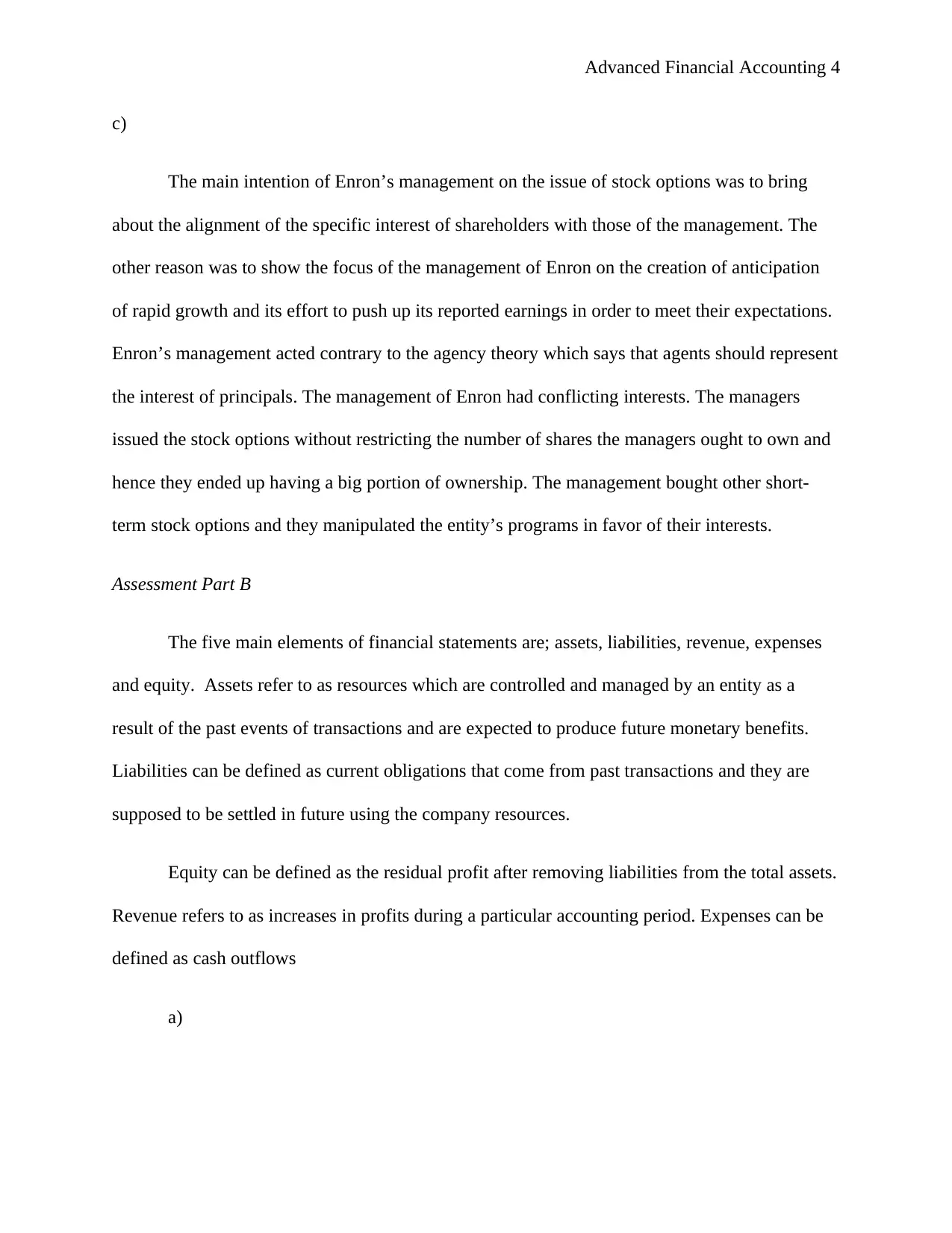
Advanced Financial Accounting 4
c)
The main intention of Enron’s management on the issue of stock options was to bring
about the alignment of the specific interest of shareholders with those of the management. The
other reason was to show the focus of the management of Enron on the creation of anticipation
of rapid growth and its effort to push up its reported earnings in order to meet their expectations.
Enron’s management acted contrary to the agency theory which says that agents should represent
the interest of principals. The management of Enron had conflicting interests. The managers
issued the stock options without restricting the number of shares the managers ought to own and
hence they ended up having a big portion of ownership. The management bought other short-
term stock options and they manipulated the entity’s programs in favor of their interests.
Assessment Part B
The five main elements of financial statements are; assets, liabilities, revenue, expenses
and equity. Assets refer to as resources which are controlled and managed by an entity as a
result of the past events of transactions and are expected to produce future monetary benefits.
Liabilities can be defined as current obligations that come from past transactions and they are
supposed to be settled in future using the company resources.
Equity can be defined as the residual profit after removing liabilities from the total assets.
Revenue refers to as increases in profits during a particular accounting period. Expenses can be
defined as cash outflows
a)
c)
The main intention of Enron’s management on the issue of stock options was to bring
about the alignment of the specific interest of shareholders with those of the management. The
other reason was to show the focus of the management of Enron on the creation of anticipation
of rapid growth and its effort to push up its reported earnings in order to meet their expectations.
Enron’s management acted contrary to the agency theory which says that agents should represent
the interest of principals. The management of Enron had conflicting interests. The managers
issued the stock options without restricting the number of shares the managers ought to own and
hence they ended up having a big portion of ownership. The management bought other short-
term stock options and they manipulated the entity’s programs in favor of their interests.
Assessment Part B
The five main elements of financial statements are; assets, liabilities, revenue, expenses
and equity. Assets refer to as resources which are controlled and managed by an entity as a
result of the past events of transactions and are expected to produce future monetary benefits.
Liabilities can be defined as current obligations that come from past transactions and they are
supposed to be settled in future using the company resources.
Equity can be defined as the residual profit after removing liabilities from the total assets.
Revenue refers to as increases in profits during a particular accounting period. Expenses can be
defined as cash outflows
a)
Paraphrase This Document
Need a fresh take? Get an instant paraphrase of this document with our AI Paraphraser
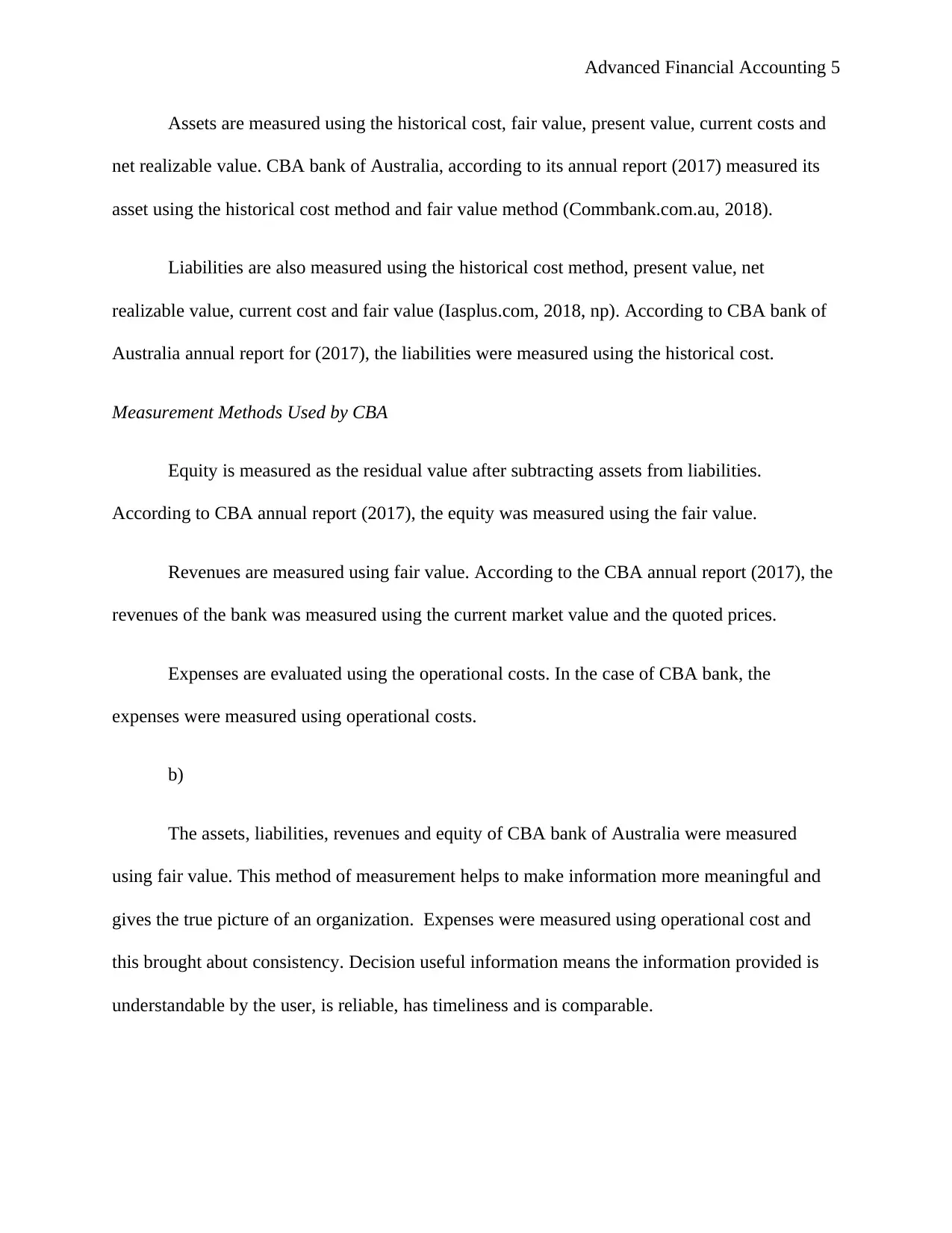
Advanced Financial Accounting 5
Assets are measured using the historical cost, fair value, present value, current costs and
net realizable value. CBA bank of Australia, according to its annual report (2017) measured its
asset using the historical cost method and fair value method (Commbank.com.au, 2018).
Liabilities are also measured using the historical cost method, present value, net
realizable value, current cost and fair value (Iasplus.com, 2018, np). According to CBA bank of
Australia annual report for (2017), the liabilities were measured using the historical cost.
Measurement Methods Used by CBA
Equity is measured as the residual value after subtracting assets from liabilities.
According to CBA annual report (2017), the equity was measured using the fair value.
Revenues are measured using fair value. According to the CBA annual report (2017), the
revenues of the bank was measured using the current market value and the quoted prices.
Expenses are evaluated using the operational costs. In the case of CBA bank, the
expenses were measured using operational costs.
b)
The assets, liabilities, revenues and equity of CBA bank of Australia were measured
using fair value. This method of measurement helps to make information more meaningful and
gives the true picture of an organization. Expenses were measured using operational cost and
this brought about consistency. Decision useful information means the information provided is
understandable by the user, is reliable, has timeliness and is comparable.
Assets are measured using the historical cost, fair value, present value, current costs and
net realizable value. CBA bank of Australia, according to its annual report (2017) measured its
asset using the historical cost method and fair value method (Commbank.com.au, 2018).
Liabilities are also measured using the historical cost method, present value, net
realizable value, current cost and fair value (Iasplus.com, 2018, np). According to CBA bank of
Australia annual report for (2017), the liabilities were measured using the historical cost.
Measurement Methods Used by CBA
Equity is measured as the residual value after subtracting assets from liabilities.
According to CBA annual report (2017), the equity was measured using the fair value.
Revenues are measured using fair value. According to the CBA annual report (2017), the
revenues of the bank was measured using the current market value and the quoted prices.
Expenses are evaluated using the operational costs. In the case of CBA bank, the
expenses were measured using operational costs.
b)
The assets, liabilities, revenues and equity of CBA bank of Australia were measured
using fair value. This method of measurement helps to make information more meaningful and
gives the true picture of an organization. Expenses were measured using operational cost and
this brought about consistency. Decision useful information means the information provided is
understandable by the user, is reliable, has timeliness and is comparable.

Advanced Financial Accounting 6
c)
CBA bank measured its assets, liabilities, revenues and equity using fair value. This
method is important because, it shows consistency, materiality and impartiality. Expenses were
measured using the operational cost; this method is significant because it brings about
understandability.
Bond Liabilities and Interest Expense
Bond issuers act as lenders because bonds are issued in form of money. After a period of
every six months, the bond borrowers are required to pay interest on the bonds which known as
the interest expense. The face value of the bond is paid during the maturity of the bond. Face
value payment is completed in a single date when the bond is fully matured.
Straight Line Method
Businesses trade their bonds at premium or at discounts. In the straight-line method, if
the bond is sold on premium, the bond premium ought to be discounted to zero. Example if a
business sells a bond at a premium of $ 8000, the premium amount has to be discounted back to
zero during the lifetime of the bond and in this case, it may be 6 years. While discounting, the
bond value which was, for example, $ 108000 will reduce yearly to $ 100000 and this termed as
amortization. At the end of every financial year, the payable bonds are debited and the interest
expense credited, this activity is repeated in the lifetime of the bond. This method is the easiest
way of reporting for bond discount and premiums.
c)
CBA bank measured its assets, liabilities, revenues and equity using fair value. This
method is important because, it shows consistency, materiality and impartiality. Expenses were
measured using the operational cost; this method is significant because it brings about
understandability.
Bond Liabilities and Interest Expense
Bond issuers act as lenders because bonds are issued in form of money. After a period of
every six months, the bond borrowers are required to pay interest on the bonds which known as
the interest expense. The face value of the bond is paid during the maturity of the bond. Face
value payment is completed in a single date when the bond is fully matured.
Straight Line Method
Businesses trade their bonds at premium or at discounts. In the straight-line method, if
the bond is sold on premium, the bond premium ought to be discounted to zero. Example if a
business sells a bond at a premium of $ 8000, the premium amount has to be discounted back to
zero during the lifetime of the bond and in this case, it may be 6 years. While discounting, the
bond value which was, for example, $ 108000 will reduce yearly to $ 100000 and this termed as
amortization. At the end of every financial year, the payable bonds are debited and the interest
expense credited, this activity is repeated in the lifetime of the bond. This method is the easiest
way of reporting for bond discount and premiums.
⊘ This is a preview!⊘
Do you want full access?
Subscribe today to unlock all pages.

Trusted by 1+ million students worldwide
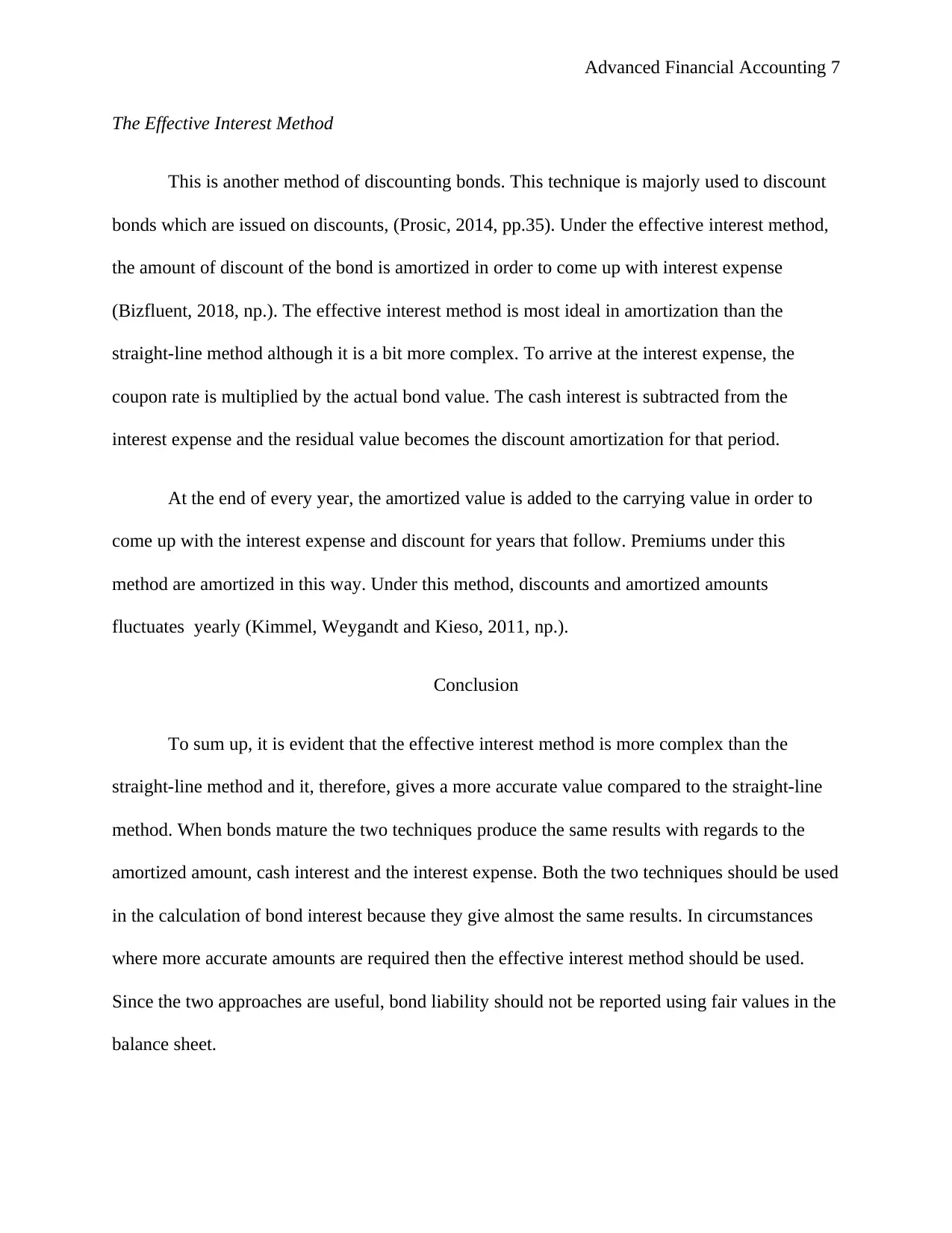
Advanced Financial Accounting 7
The Effective Interest Method
This is another method of discounting bonds. This technique is majorly used to discount
bonds which are issued on discounts, (Prosic, 2014, pp.35). Under the effective interest method,
the amount of discount of the bond is amortized in order to come up with interest expense
(Bizfluent, 2018, np.). The effective interest method is most ideal in amortization than the
straight-line method although it is a bit more complex. To arrive at the interest expense, the
coupon rate is multiplied by the actual bond value. The cash interest is subtracted from the
interest expense and the residual value becomes the discount amortization for that period.
At the end of every year, the amortized value is added to the carrying value in order to
come up with the interest expense and discount for years that follow. Premiums under this
method are amortized in this way. Under this method, discounts and amortized amounts
fluctuates yearly (Kimmel, Weygandt and Kieso, 2011, np.).
Conclusion
To sum up, it is evident that the effective interest method is more complex than the
straight-line method and it, therefore, gives a more accurate value compared to the straight-line
method. When bonds mature the two techniques produce the same results with regards to the
amortized amount, cash interest and the interest expense. Both the two techniques should be used
in the calculation of bond interest because they give almost the same results. In circumstances
where more accurate amounts are required then the effective interest method should be used.
Since the two approaches are useful, bond liability should not be reported using fair values in the
balance sheet.
The Effective Interest Method
This is another method of discounting bonds. This technique is majorly used to discount
bonds which are issued on discounts, (Prosic, 2014, pp.35). Under the effective interest method,
the amount of discount of the bond is amortized in order to come up with interest expense
(Bizfluent, 2018, np.). The effective interest method is most ideal in amortization than the
straight-line method although it is a bit more complex. To arrive at the interest expense, the
coupon rate is multiplied by the actual bond value. The cash interest is subtracted from the
interest expense and the residual value becomes the discount amortization for that period.
At the end of every year, the amortized value is added to the carrying value in order to
come up with the interest expense and discount for years that follow. Premiums under this
method are amortized in this way. Under this method, discounts and amortized amounts
fluctuates yearly (Kimmel, Weygandt and Kieso, 2011, np.).
Conclusion
To sum up, it is evident that the effective interest method is more complex than the
straight-line method and it, therefore, gives a more accurate value compared to the straight-line
method. When bonds mature the two techniques produce the same results with regards to the
amortized amount, cash interest and the interest expense. Both the two techniques should be used
in the calculation of bond interest because they give almost the same results. In circumstances
where more accurate amounts are required then the effective interest method should be used.
Since the two approaches are useful, bond liability should not be reported using fair values in the
balance sheet.
Paraphrase This Document
Need a fresh take? Get an instant paraphrase of this document with our AI Paraphraser
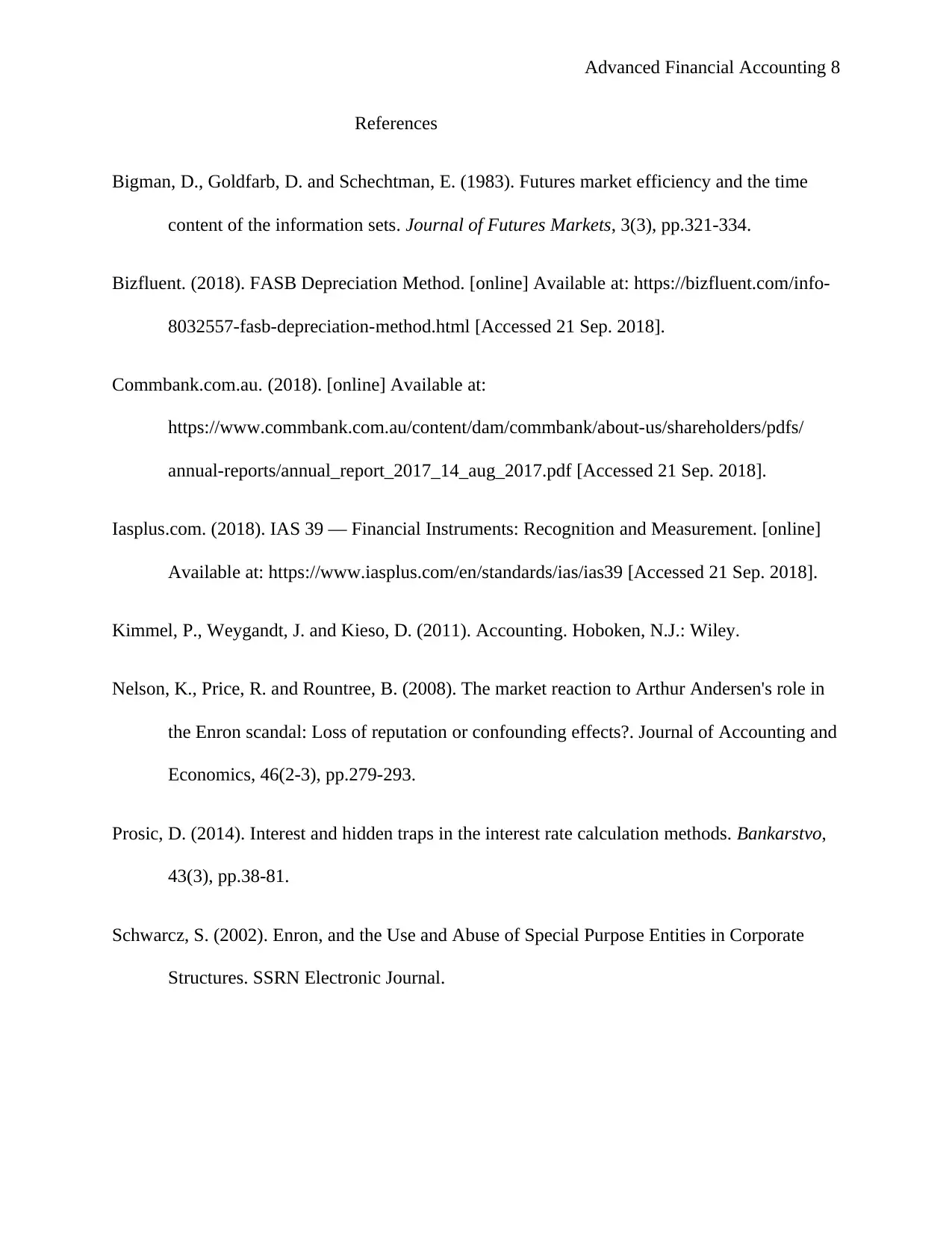
Advanced Financial Accounting 8
References
Bigman, D., Goldfarb, D. and Schechtman, E. (1983). Futures market efficiency and the time
content of the information sets. Journal of Futures Markets, 3(3), pp.321-334.
Bizfluent. (2018). FASB Depreciation Method. [online] Available at: https://bizfluent.com/info-
8032557-fasb-depreciation-method.html [Accessed 21 Sep. 2018].
Commbank.com.au. (2018). [online] Available at:
https://www.commbank.com.au/content/dam/commbank/about-us/shareholders/pdfs/
annual-reports/annual_report_2017_14_aug_2017.pdf [Accessed 21 Sep. 2018].
Iasplus.com. (2018). IAS 39 — Financial Instruments: Recognition and Measurement. [online]
Available at: https://www.iasplus.com/en/standards/ias/ias39 [Accessed 21 Sep. 2018].
Kimmel, P., Weygandt, J. and Kieso, D. (2011). Accounting. Hoboken, N.J.: Wiley.
Nelson, K., Price, R. and Rountree, B. (2008). The market reaction to Arthur Andersen's role in
the Enron scandal: Loss of reputation or confounding effects?. Journal of Accounting and
Economics, 46(2-3), pp.279-293.
Prosic, D. (2014). Interest and hidden traps in the interest rate calculation methods. Bankarstvo,
43(3), pp.38-81.
Schwarcz, S. (2002). Enron, and the Use and Abuse of Special Purpose Entities in Corporate
Structures. SSRN Electronic Journal.
References
Bigman, D., Goldfarb, D. and Schechtman, E. (1983). Futures market efficiency and the time
content of the information sets. Journal of Futures Markets, 3(3), pp.321-334.
Bizfluent. (2018). FASB Depreciation Method. [online] Available at: https://bizfluent.com/info-
8032557-fasb-depreciation-method.html [Accessed 21 Sep. 2018].
Commbank.com.au. (2018). [online] Available at:
https://www.commbank.com.au/content/dam/commbank/about-us/shareholders/pdfs/
annual-reports/annual_report_2017_14_aug_2017.pdf [Accessed 21 Sep. 2018].
Iasplus.com. (2018). IAS 39 — Financial Instruments: Recognition and Measurement. [online]
Available at: https://www.iasplus.com/en/standards/ias/ias39 [Accessed 21 Sep. 2018].
Kimmel, P., Weygandt, J. and Kieso, D. (2011). Accounting. Hoboken, N.J.: Wiley.
Nelson, K., Price, R. and Rountree, B. (2008). The market reaction to Arthur Andersen's role in
the Enron scandal: Loss of reputation or confounding effects?. Journal of Accounting and
Economics, 46(2-3), pp.279-293.
Prosic, D. (2014). Interest and hidden traps in the interest rate calculation methods. Bankarstvo,
43(3), pp.38-81.
Schwarcz, S. (2002). Enron, and the Use and Abuse of Special Purpose Entities in Corporate
Structures. SSRN Electronic Journal.
1 out of 8
Related Documents
Your All-in-One AI-Powered Toolkit for Academic Success.
+13062052269
info@desklib.com
Available 24*7 on WhatsApp / Email
![[object Object]](/_next/static/media/star-bottom.7253800d.svg)
Unlock your academic potential
Copyright © 2020–2025 A2Z Services. All Rights Reserved. Developed and managed by ZUCOL.




